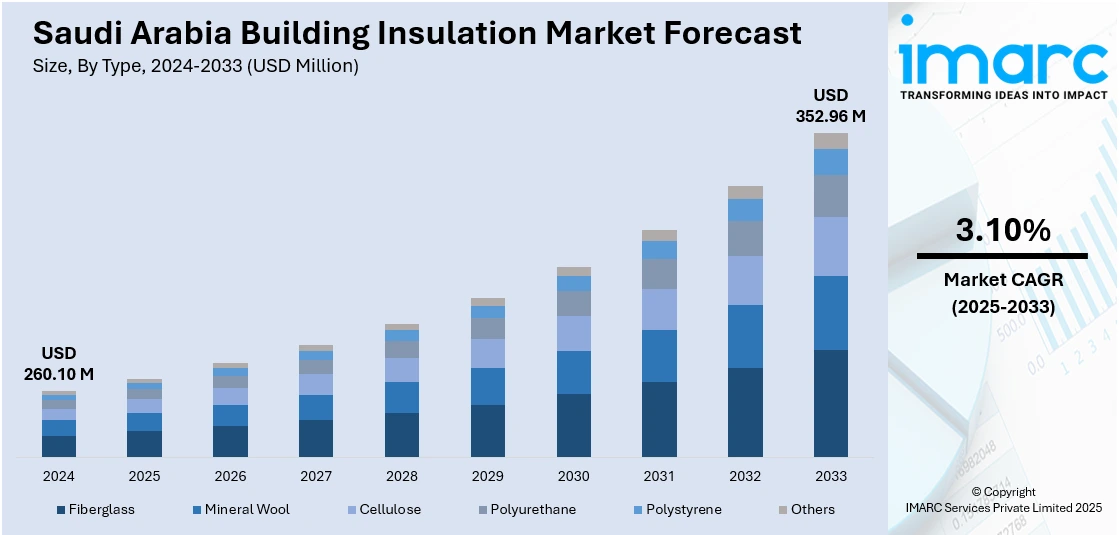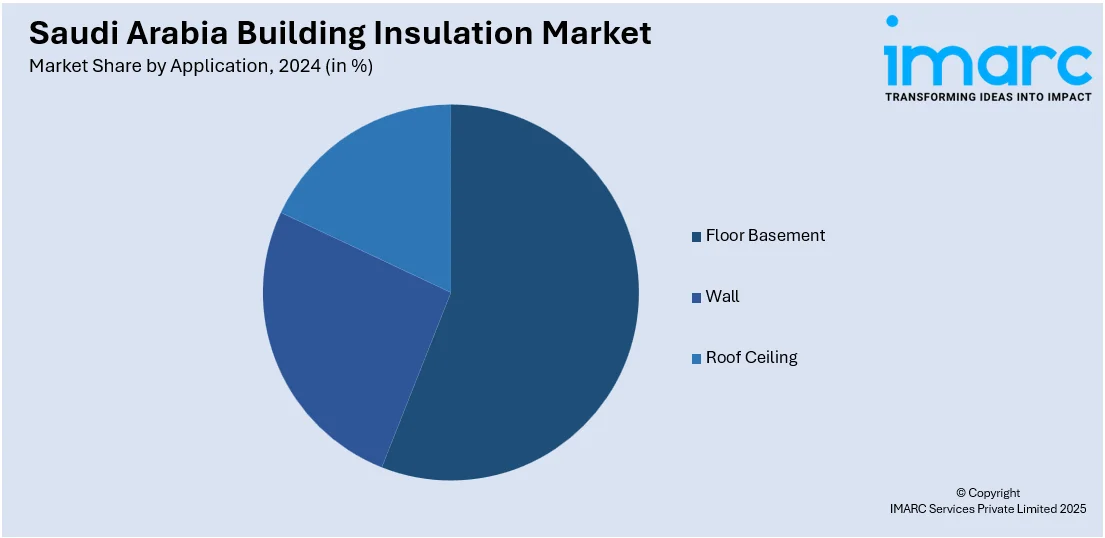
Saudi Arabia Building Insulation Market Size, Share, Trends and Forecast by Type, Application, End User, and Region, 2025-2033
Saudi Arabia Building Insulation Market Overview:
The Saudi Arabia building insulation market size reached USD 260.10 Million in 2024. Looking forward, IMARC Group expects the market to reach USD 352.96 Million by 2033, exhibiting a growth rate (CAGR) of 3.10% during 2025-2033. The increasing need for energy-efficient buildings is impelling the growth of the market. Moreover, the government of Saudi Arabia is actively implementing more stringent building standards and regulations to enhance energy efficiency and environmental sustainability. This trend, along with the rise in construction activities, is expanding the Saudi Arabia building insulation market share.
|
Report Attribute
|
Key Statistics
|
|---|---|
|
Base Year
|
2024 |
|
Forecast Years
|
2025-2033
|
|
Historical Years
|
2019-2024
|
| Market Size in 2024 | USD 260.10 Million |
| Market Forecast in 2033 | USD 352.96 Million |
| Market Growth Rate 2025-2033 | 3.10% |
Saudi Arabia Building Insulation Market Trends:
Increasing Demand for Energy Efficiency
The increasing need for energy-efficient buildings is impelling the growth of the market. The nation, with a focus on sustainability and decreasing dependence on energy-hungry cooling systems, is seeing a high demand for high-performance insulation materials. With temperatures in Saudi Arabia consistently reaching extremely high levels, buildings lacking proper insulation suffer from high heat gain, resulting in increased energy use for air conditioning. Consequently, both the residential and commercial markets are embracing insulation technologies to reduce heat loss and gain to save energy and lower operational expenses. The government is also sensitizing the nation on energy efficiency through policies, like Saudi Vision 2030, to persuade the building of more insulated buildings in accordance with regulatory requirements. Furthermore, increasing awareness about energy saving is encouraging building constructors and developers to focus on insulation during new build developments and refurbishment. In 2024, the National Energy Services Company (Tarshid) and Saudi Railways (SAR) signed an agreement to introduce energy-saving measures and maximize energy efficiency on SAR's headquarters building and SAR's Riyadh North Station buildings and facilities. This was the first such agreement among the Kingdom's private, logistics, and transport sectors in line with Saudi Vision 2030 and the Saudi Green Initiative by implementing sustainable and low-carbon energy solutions.

Government Regulations and Standards
The implementation of government policies is contributing to the Saudi Arabia building insulation market growth. The government of Saudi Arabia is actively executing more stringent building standards and regulations to enhance energy efficiency and environmental sustainability. The policies are promoting the extensive use of insulation materials in residential, commercial, and industrial structures. The enforcement of energy-savings codes, including thermal insulation codes for building, is guaranteeing that construction projects adhere to energy-saving standards. The enactment of the "Saudi Building Code" highlights the importance of thermal insulation further by mandating building envelopes to comply with certain performance levels. Thus, the requirement for new-generation insulation products is increasing, with architects and builders working to comply with the regulations. The government's focus on sustainable development is also following international trends in minimizing carbon footprints, thereby providing a conducive environment for suppliers of insulation products in the country.
Rising Construction Activities
The rise in construction activities in Saudi Arabia is driving the demand for building insulation. The country is experiencing a surge in both residential and commercial real estate development, fueled by population growth and increasing foreign investments. Projects related to large-scale infrastructure developments, such as hotels, offices, and retail complexes, are further catalyzing the demand for insulation materials. With a strong emphasis on modernizing the nation's infrastructure, more developers are incorporating insulation technologies to improve building performance and meet evolving preferences. The increasing number of high-end residential projects, in particular, is creating a need for superior thermal insulation solutions to enhance comfort and reduce energy costs. Additionally, the construction boom, driven by the Saudi Vision 2030 plan, is positively influencing the market, as developers strive to incorporate eco-friendly and energy-efficient features into their building designs. The IMARC Group predicts that the Saudi Arabia construction market size is projected to reach USD 135.6 Billion by 2033.
Saudi Arabia Building Insulation Market Segmentation:
IMARC Group provides an analysis of the key trends in each segment of the market, along with forecasts at the country and regional levels for 2025-2033. Our report has categorized the market based on type, application, and end user.
Type Insights:
- Fiberglass
- Mineral Wool
- Cellulose
- Polyurethane
- Polystyrene
- Others
The report has provided a detailed breakup and analysis of the market based on the type. This includes fiberglass, mineral wool, cellulose, polyurethane, polystyrene, and others.
Application Insights:

- Floor Basement
- Wall
- Roof Ceiling
The report has provided a detailed breakup and analysis of the market based on the application. This includes floor basement, wall, and roof ceiling.
End User Insights:
- Residential
- Non-Residential
A detailed breakup and analysis of the market based on the end user have also been provided in the report. This includes residential and non-residential.
Regional Insights:
- Northern and Central Region
- Western Region
- Eastern Region
- Southern Region
The report has also provided a comprehensive analysis of all the major regional markets, which include Northern and Central Region, Western Region, Eastern Region, and Southern Region.
Competitive Landscape:
The market research report has also provided a comprehensive analysis of the competitive landscape. Competitive analysis such as market structure, key player positioning, top winning strategies, competitive dashboard, and company evaluation quadrant has been covered in the report. Also, detailed profiles of all major companies have been provided.
Saudi Arabia Building Insulation Market Report Coverage:
| Report Features | Details |
|---|---|
| Base Year of the Analysis | 2024 |
| Historical Period | 2019-2024 |
| Forecast Period | 2025-2033 |
| Units | Million USD |
| Scope of the Report |
Exploration of Historical Trends and Market Outlook, Industry Catalysts and Challenges, Segment-Wise Historical and Future Market Assessment:
|
| Types Covered | Fiberglass, Mineral Wool, Cellulose, Polyurethane, Polystyrene, Others |
| Applications Covered | Floor Basement, Wall, Roof Ceiling |
| End Users Covered | Residential, Non-Residential |
| Regions Covered | Northern and Central Region, Western Region, Eastern Region, Southern Region |
| Customization Scope | 10% Free Customization |
| Post-Sale Analyst Support | 10-12 Weeks |
| Delivery Format | PDF and Excel through Email (We can also provide the editable version of the report in PPT/Word format on special request) |
Key Questions Answered in This Report:
- How has the Saudi Arabia building insulation market performed so far and how will it perform in the coming years?
- What is the breakup of the Saudi Arabia building insulation market on the basis of type?
- What is the breakup of the Saudi Arabia building insulation market on the basis of application?
- What is the breakup of the Saudi Arabia building insulation market on the basis of end user?
- What is the breakup of the Saudi Arabia building insulation market on the basis of region?
- What are the various stages in the value chain of the Saudi Arabia building insulation market?
- What are the key driving factors and challenges in the Saudi Arabia building insulation market?
- What is the structure of the Saudi Arabia building insulation market and who are the key players?
- What is the degree of competition in the Saudi Arabia building insulation market?
Key Benefits for Stakeholders:
- IMARC’s industry report offers a comprehensive quantitative analysis of various market segments, historical and current market trends, market forecasts, and dynamics of the Saudi Arabia building insulation market from 2019-2033.
- The research report provides the latest information on the market drivers, challenges, and opportunities in the Saudi Arabia building insulation market.
- Porter's five forces analysis assist stakeholders in assessing the impact of new entrants, competitive rivalry, supplier power, buyer power, and the threat of substitution. It helps stakeholders to analyze the level of competition within the Saudi Arabia building insulation industry and its attractiveness.
- Competitive landscape allows stakeholders to understand their competitive environment and provides an insight into the current positions of key players in the market.
Need more help?
- Speak to our experienced analysts for insights on the current market scenarios.
- Include additional segments and countries to customize the report as per your requirement.
- Gain an unparalleled competitive advantage in your domain by understanding how to utilize the report and positively impacting your operations and revenue.
- For further assistance, please connect with our analysts.
 Request Customization
Request Customization
 Speak to an Analyst
Speak to an Analyst
 Request Brochure
Request Brochure
 Inquire Before Buying
Inquire Before Buying




.webp)




.webp)












